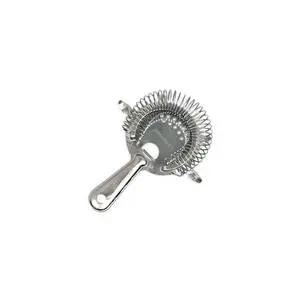As most successful operators know, one of the most profitable segments of the industry can often be your beverage program. High margins combined with minimal preparation makes having a solid bar program a great source of revenue. Setting up your operation to be quick and efficient can easily add to profits. Minimizing a bartender’s movement can streamline an operation and allow operators to sell more dinks. This can easily be accomplished by breaking a bar down to properly equipped stations to maximize efficiency.
Basic bar station necessities
A properly stocked bar area means bartenders have all the tools they require to produce any drink on or off the menu. Here are most of the smallwares needed behind every bar trying to cash in on trendy beverage service:
Cocktail shaker
Used to mix and shake cocktails, a proper Martini or Manhattan can’t be made without one. Depending on the beverage program, multiple shakers and / or different sizes should be behind the bar.
Bar spoon
To craft the classic Martini or a beverage featuring delicate spirits such as St. Germaine, this tool will be necessary to stir.
Strainer
Strainers are absolutely necessary when working with a cocktail shaker.
Corkscrews & bottle openers
These items are standard for anyone working behind the bar.
Multiple jiggers
For accurately measuring, spirits, several sizes of jiggers will be necessary. Efficient bars will fully stock each bartender’s station, as this would prevent borrowing of equipment and potentially reduce backups.
Muddler
Used to mash ingredients in the bottom of the glass as a flavor base, classics like the Mojito and Old Fashioned rely on this bar tool.
Zesters & peelers
As bartenders continue to push the boundaries of mixology, citrus zests, vegetable peels, and other garnishes will be needed for cocktails. It may not be prudent to cut these garnishes in advance of preparing the drink, so it is best to have a simple zester or peeler available.
Condiment caddy
A sanitary (a properly cooled) area is needed to store cut fruit, cherries, olives and other beverage garnishes, and a condiment caddy does that and more. These systems keep garnishes on hand for bartenders, without creating a cluttered mess or violating any health codes.
Glass rimmer
With a sponge filled station to hold a liquid and a dry section to hold a dry mixture, this tool can be used for classic applications such as lime juice and salt for a classic margarita or allow the operator to kick up other cocktails by adding sugar, salt, or spice mixes to the rim.
Napkin, straw and stirrer caddies
Having these necessities close-by and organized helps keep the drinks flowing and the profits growing.
Pour Bottles
Uniform slender bottles keep mixers organized, close by, and have a time tested shape for ease of use and efficiency.
Optional bar tools
Successful owners also know that monitoring your inventory is the key to maximizing your profits. There are several items that can help insure that every ounce of profit is being capitalized on.
Calibrated bar pourers
The pourers automatically dispense the same amount or liquor each time, and are available in ¼ oz increments.
Training kits
A great tool in monitoring the accuracy of your bar staff, these kits also help business owners / managers properly train new employees.
Digital scales
Opening and closing inventories can help spot employee consumption or theft quickly.


